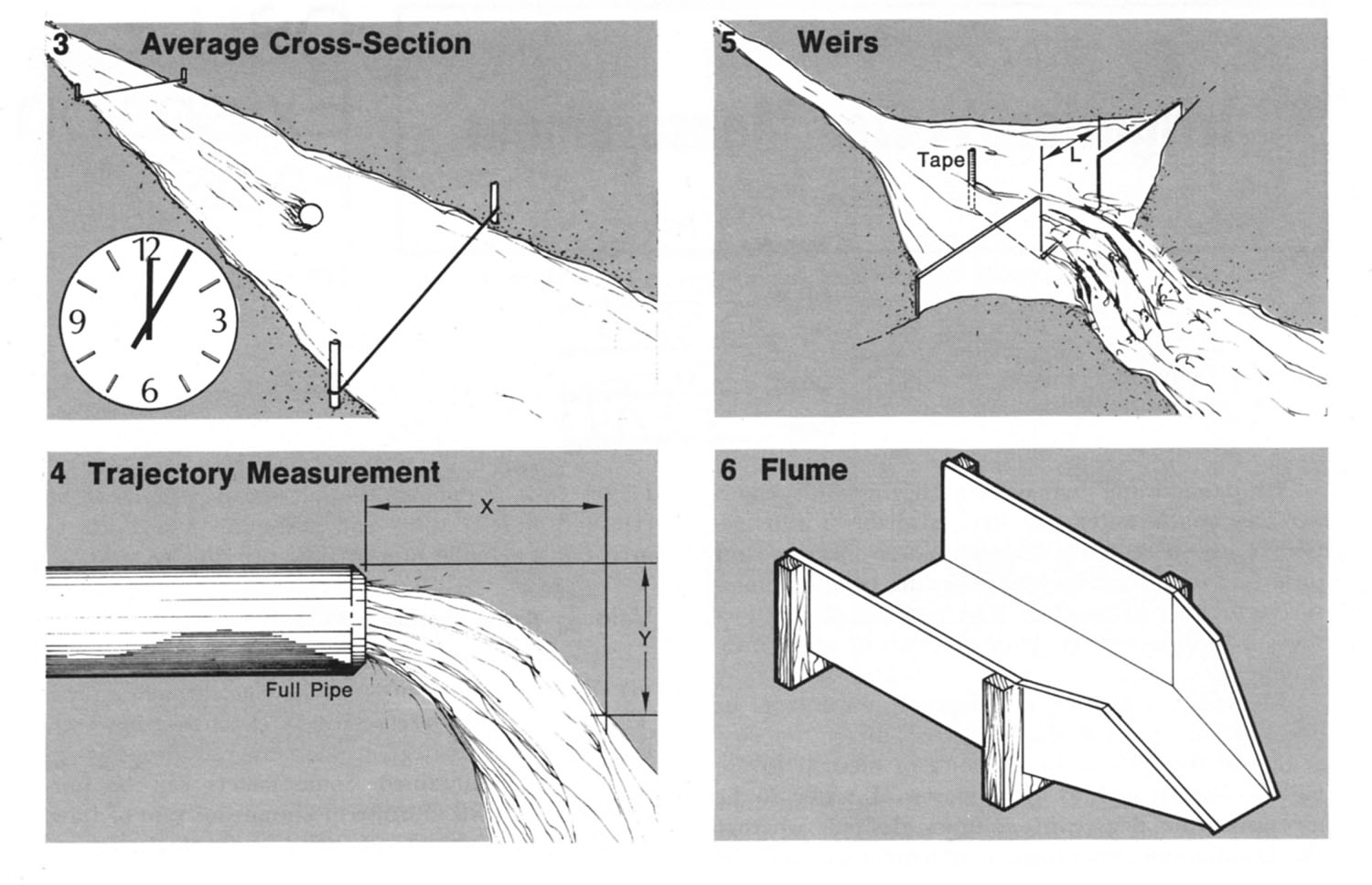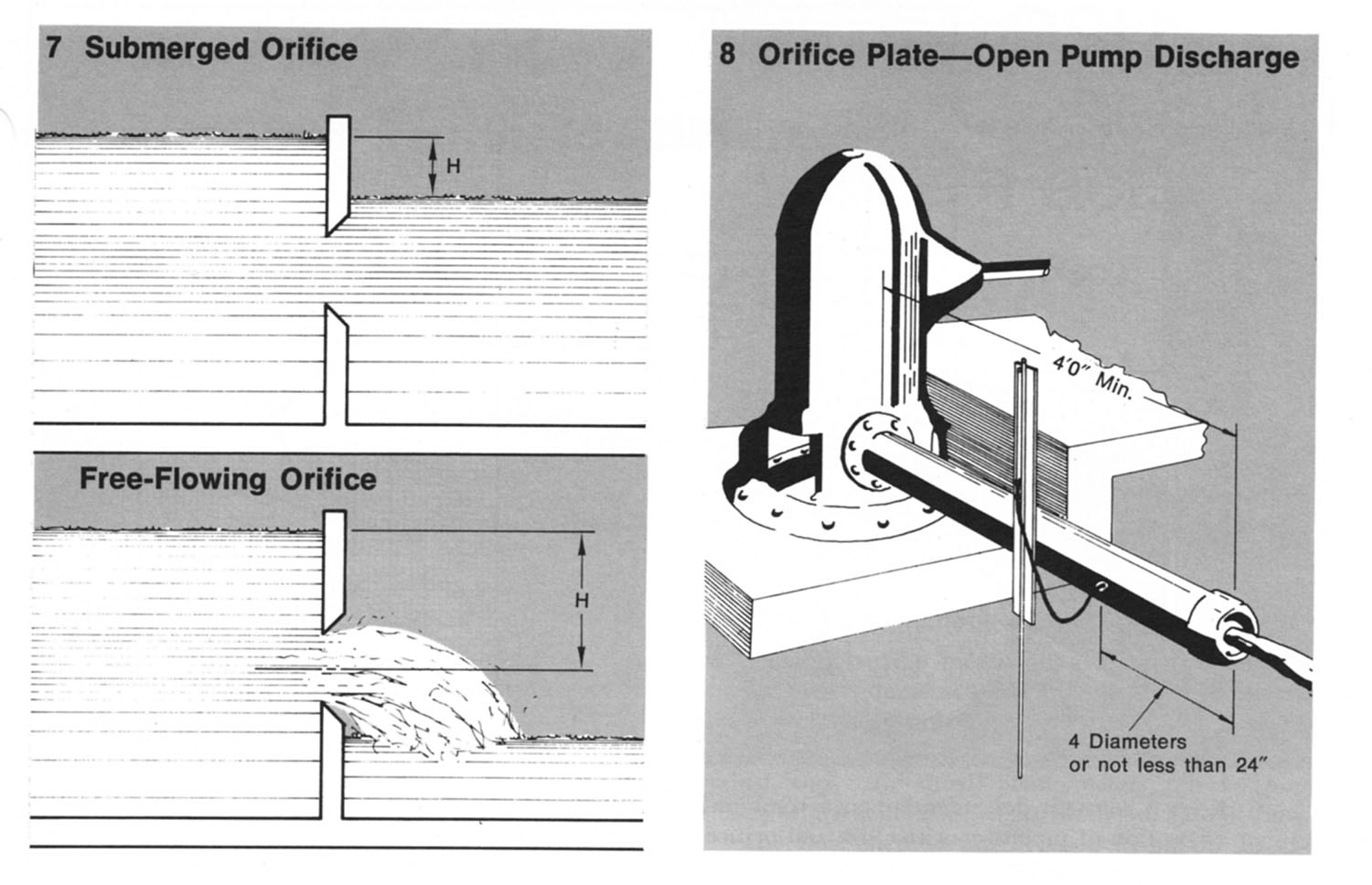Irrigation Water Flow Measurement
Irrigation water management begins with knowing how much water is available for irrigation. Fact Sheet 1501, discusses water measurement units and useful factors for converting from one measurement unit to another. The purpose of this fact sheet is to discuss a few basic methods of water flow measurement.
Methods of measuring irrigation flow rate can be grouped into three basic categories—direct, velocity-area, and constricted flow. Choice of method to use will be determined by the volume of water to be measured, the degree of accuracy desired, whether the installation is permanent or temporary, and the financial investment required.
Direct Measurement Methods (1)
Measuring the period of time required to fill a container of a known volume can be used to measure small rates of flow such as from individual siphon tubes, sprinkler nozzles, or from individual outlets in gated pipe. Ordinarily one gallon or five gallon containers will be adequate. Small wells can be measured by using a 55 gallon barrel as the container. It is recommended that the measurement be repeated at least three and preferably five times to arrive at a reliable rate of flow per unit of time.
Velocity-Area Methods
Flow Meters (2)
Commercial flow meters are available for measuring the total volume of water flowing through a pipe. These flow meters are relatively expensive; however, they have a good degree of accuracy if properly installed and maintained. The most common type of flow meter is the propeller meter. Depending on its type, these meters may give the flow rate or the total volume or both.
Several points should be considered in propeller meter installation and management:
- The readings are accurate only if the pipe is flowing full. The flow may not be full at cerain parts of the pipe, such as before discharge points.
- Meters should be installed at a point where turbulance is minimum. This usually occurs after an extended length of straight pipe.
- Meters should be calibrated on a regular basis.
- Debris, weeds and moss in irrigation water reduces the accuracy by impacting the propeller’s rotation.
Float Method (3)
The float method can be used to obtain an approximate measure of the rate of flow occurring in an open ditch. It is especially useful where more expensive installations are not justified or high degree accuracy is not required.
Select a straight section of ditch from 50 to 100 feet long with fairly uniform cross-sections. Make several measurements of the width and depth of the test cross-section so as to arrive at an average cross-sectional area. Using a tape, measure the length of the test section of the ditch. Place a small floating object in the ditch a few feet above the starting point of the test section and time the number of seconds for this object to travel the length of the test section. This time measurement should be made several times to arrive at a reliable average value. By dividing the length of the test section (feet) by the average time required (seconds), one can estimate velocity in feet per second. Since the velocity of water at the surface is greater than the average velocity of the stream, multiply the estimated surface velocity by a correction factor (0.80 for smooth lined ditches, and 0.60 for rough ditches) to obtain the average stream velocity.
To obtain the rate of flow, multiply the average cross-sectional area of the ditch (square feet) times the average stream velocity (feet per second) and the answer is the rate of flow in cubic feet per second.
Trajectory Method (4)
The trajectory method of water measurement is a form of velocity area calculations that can be used for obtaining a rapid and rough estimate of flow rate discharging from a horizontal pipe flowing full. Two measurements of the discharging jet are required to calculate the rate of flow of the water. The first measurement is the horizontal distance, “X”, (parallel to the centerline of the pipe) required for the jet to drop a vertical distance “Y” which is the second measurement.
By using ”Y” equal to either 6 or 12 inches, the rate of flow for full pipes can be calculated by multiplying the horizontal distance “X” (in inches) times the appropriate factor for the nominal pipe diameter. The following table contains water discharge factor where “Y” is measured from the outside of the pipe to the top of the water jet as indicated in Figure 4.
Table: Water Discharge Factor ;( Graphic View )
| Nominal Pipe Diameter | Factor When Y=6 | Factor When Y=12 | |
|---|---|---|---|
| 2" | 5.02 | 3.52 | |
| 3" | 11..13 | 7.77 | |
| 4" | 17.18 | 13.4 | |
| 6" | 43.7 | 30.6 | |
| 8" | 76.0 | 52.9 | |
| 10" | 120.0 | 83.5 | |
| 12" | 173.0 | 120.0 |
EXAMPLE: A farmer has a well discharging a full 8″ pipe. The horizontal distance (X) is 19″ while the jet surface drops 12″. What is the well yield?
Step 1: Enter the water discharge factor table at 8″ nominal pipe diameter. Moving to the right and under the column headed Y = 12″ we find the factor to be 52.9.
Step 2: Multiplying this factor 52.9, times the horizontal distance, 19″ calculate the well yield to be 1,005 gpm.
Constriction Flow Methods (5,6,7,8,9,10)
Methods employing a constriction of pre-determined dimensions are frequently used for measuring flow in irrigation canals and ditches. Constricting type measuring devices can generally be placed in one of three categories—weirs, flumes, and orifices.
Generally, only one or two measurements are required where the dimensions of the constriction are known. Using these measurements, rate of flow is determined from either a table, a graph, or by calculation. Due to the wide variety of types and sizes of constricting devices, flow tables are not included in this publication. The local County Extension Director or local USDA office can obtain such tables or graphs.
Basically, a weir measures flow by causing the water to flow over a notch of pre-determined shape and dimensions. They are quite accurate when properly constructed, installed, and maintained. Weirs do have some limitations. First, they require considerable drop (difference in head) between the upstream and downstream water surfaces which is often either not available in flat grade ditches or is undesirable. Second, it is frequently necessary to construct a pool or stilling area above the weir so the water loses its velocity. Unless the water appears practically still, discharge readings will be inaccurate. Weir installations in earthen ditches can be particularly troublesome. The stilling area in the ditch above the weir frequently tends to “silt in” while excessive erosion may occur immediately downstream from the weir.
A flume measures flow by causing the water to flow through a channel of pre-determined dimensions. Flumes usually can operate with less difference in elevation between upstream and downstream water surfaces than can weirs. Like weirs, when properly installed and maintained, flumes are quite accurate means of measuring water flow.
An orifice measures water flowing through an opening of pre-determined shape and size. For a given amount of head (pressure) a specific quantity of water will flow through the opening. Orifices can be classified as “free flowing” where the flow from the orifice discharges entirely into air or “fully submerged” where the downstream water surface is above the top of the orifice and the flow discharges into water. Avoid orifices that do not flow free or are not completely submerged.
Orifice plates properly installed on open pump discharges can provide a relatively inexpensive and reasonably accurate means of measuring well discharge. It is very important that the opening in the orifice plate be accurately machined to dimension. Slight variation from specified dimensions can cause wide variation from calculated rate of flow.
The equation for calculating flow through an orifice is:
Q = K√H
Where
Q = flow in gallons per minute.
K = a constant dependent upon a combination of pipe size, orifice size and orifice shape, and discharge conditions.
H = Head in inches.
The following table gives values of K for various combinations of orifice sizes and pipe sizes discharging into air. These values of K should be used only for orifice plates machined to the dimensions shown in Illustration 9.
TABLE: Value of K ; (Graphic View)
| Pipe Size in Inches | 3 | 4 | 5 | 6 | 7 | 8 | |
|---|---|---|---|---|---|---|---|
| 4 | 43.3 | ||||||
| 6 | 33.3 | 63.3 | 123.0 | ||||
| 8 | 59.0 | 97.3 | 155.0 | ||||
| 10 | 141.0 | 208.0 | 311.0 |
The following graph can be used for determining the “square root” of the head (H) in inches. Having measured the head H using the glass tube and a scale, enter the graph at the left side. Move horizontally to intercept the curve and move downward to determine the square root of H (√H ).
The following is an example of how to calculate flow using an orifice plate on a pump discharge. A farmer has a 6″ orifice plate installed on an 8″ pump discharge. The orifice plate is machined to the dimension and shape shown in the sketch. He or she determines the head “H” to be 27″. Consulting the table, he or she determines the constant “K” for a 6″ orifice in an 8″ pipe to be 155. Using the graph he or she estimates the square root of 27 to be about 5.2. Substituting the values in the equation Q = K√H, Q is calculated to be 806.0 (5.2 x 155).
The final selection of the type of water flow measurement device will depend on the volume of water to be measured, the degree of accuracy desired, the desired permanence of installation, and the grade or fall of the ditch or stream. The degree of accuracy afforded by the various measurement methods of course depends upon the skill of the operator as well as the proper and careful installation of the device. The generally accepted degree of accuracy using the trajectory method is ±10 percent, while orifices, flumes, and weirs can provide ± 3 percent to 5 percent, accuracy. Commercial flow meters usually fall in the range of ± 2 percent to 4 percent. The importance of proper installation and operation as well as exercising due caution when making measurements or taking readings cannot be over emphasized. Your local County Extension Director or local USDA office can provide detailed information relative to water measurement devices.
Saleh Taghvaeian
Extension Irrigation Specialist




